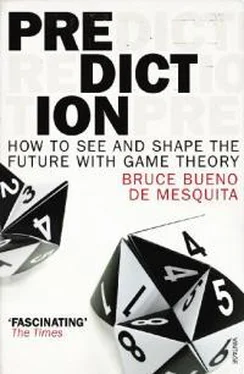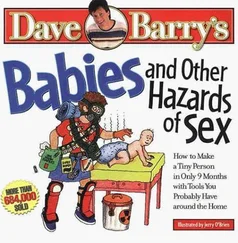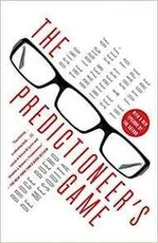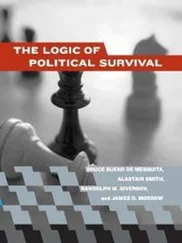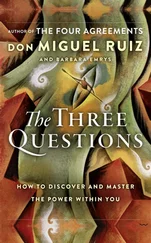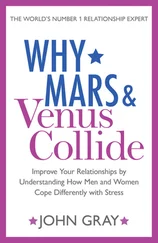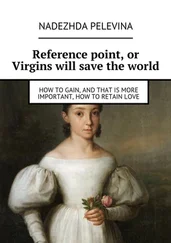The table tells us there’s quite a range of possible future relations between Iran and Iraq, and of course we need to play the game to work out what is likely to happen. From Barack Obama’s vantage point, Iraq ought not to be too quick to jump into bed with Iran. He thinks a policy around 0 on the scale is just right. That is, the Obama administration wants the two countries to go their separate ways while maintaining quiet at the borders, as is their obligation under the terms of their 1975 treaty. But that is not what Prime Minister Nuri al-Maliki wants. He advocates a concentrated strategic partnership (80 on the scale). Maliki’s government needs a protector; if it won’t be the United States, he would be content to obtain security guarantees from Iran. For him, forging a close association with his much larger neighbor makes a lot of sense. Left to his own devices, Maliki would choose a path that is opposite to the one President Obama wants. Of course, neither Maliki nor any future Iraqi leader will be left to his own devices. There’s plenty of pulls and tugs on all sides, so we really do need a tool, like game theory, to help us sort out what the future holds.
While President Obama urges Prime Minister Maliki not to make a deal with Iran, the expert data going into the game indicates that Iran’s Ayatollah Ali Khamenei—the supreme leader with a veto over all Iranian policy—welcomes an opportunity for an even closer relationship than Maliki desires. He, too, wants a mutual defense agreement, but he also wants an almost unrestricted flow of intelligence and arms dealing between his government and Iraq’s. It appears that Khamenei would like to use Iraq as a base for gathering information about the goings-on in the Arab states next door and beyond. So there is a substantial difference between Obama’s vision for Iran and Iraq and the ambitions of the leaders of those two countries.
WHAT WILL IRAQ OFFER TO IRAN?
With this bit of background in mind, we can ask what is likely to happen under two plausible scenarios: (1) Iran and Iraq first work out their respective positions through the normal internal give-and-take of domestic politics and then, having resolved the stance they will take, negotiate against the backdrop of ongoing U.S. pressure in the form of a continuing fifty-thousand-strong American military presence in Iraq; or (2) they each settle their domestic games and then negotiate their future relations bilaterally, without outside interference and with American forces fully withdrawn.
Figure 10.6A displays the evolving positions of four key political figures in Iraq: Prime Minister Maliki; vice president and leading Sunni politician Tariq al-Hashimi; Iraq’s President Jalal Talabani, who leads Iraq’s Kurdish faction; and Muqtada al-Sadr, the militant anti-American Shi’ite leader. The analysis on which the figure is based assumes that the United States will fully withdraw its troops by August 2010, an outcome favored not only by many Americans but also by many Iraqis. Figure 10.6B displays the same key Iraqi political leaders, but this time having solved the game under the assumption that the United States will maintain fifty thousand combat-ready forces in Iraq. The analyses are not precise about when Iraq’s leaders will come to a stable point of view on dealing with Iran, but they do imply that a decision will be reached not much later than August 2010—and quite possibly earlier. The issue appears to be on the back burner for now but it will surely heat up as the U.S. withdrawal date draws nearer.
The model shows that it takes six or seven bargaining rounds before Iraq’s political interests (including many more than the four leaders displayed in the figures) come to an agreement on how to deal with Iran. That is a large number of rounds before a stable outcome can emerge. So many rounds of internal discussion imply a long stretch of time between when the issue moves to the front burner and when it is settled internally. Apparently it will not be easy for the Iraqis to work out what they want their future relationship with Iran to look like.
FIG. 10.6A. The Likely Iraqi Approach to Iran If the United States Pulls Out
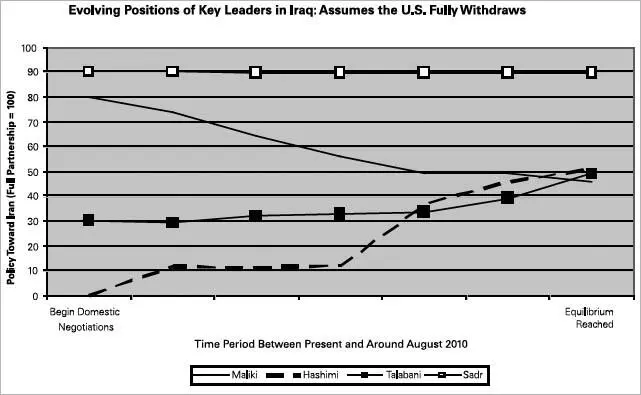
Figures 10.6A and 10.6B, viewed together, tell an interesting story. Despite their deep differences, Maliki, Talabani, and Hashimi slowly but surely come around to a collective agreement. They will support a relatively lukewarm relationship with Iran, a relationship not nearly as close as Maliki wants. According to the game, Iraqi diplomats will be authorized to seek an agreement with Iran that includes limited arms flow between the two countries, with no preparedness to transfer technology or share intelligence. In terms of a formal treaty relationship, what is likely to be sought is a promise from each not to use force against the other. That means, in the parlance of international affairs, that Iraq seeks a mutual nonaggression pact. The United States ultimately will support this undertaking, but only after a protracted negotiation. If U.S. troops remain in Iraq, Talabani will feel emboldened to press for an even weaker association with Iran, but he will not prevail. He will go along with Maliki’s compromise position if U.S. troops are withdrawn.
FIG. 10.6B. The Likely Iraqi Approach to Iran If the United States Keeps 50,000 Troops in Iraq

There is one more element in Figures 10.6A and B that is strikingly important. Muqtada al-Sadr, the militant Shia cleric, steadfastly opposes the pursuit of a watered-down, weak partnership with Iran. In the absence of a U.S. military presence, he does not budge from his initial point of view. That perspective favors almost the most extreme partnership anyone advocates. Indeed, as we will see, only some Iranian leaders—like Ahmadinejad—want as much. Sadr advocates a free flow of arms and military technology between the two countries, accompanied by a mutual defense alliance and joint intelligence operations. He will back ever so slightly away from that extreme position if the United States retains troops in Iraq, presumably out of concern for the security of his own operations.
IRAQ’S POLITICAL WINNERS AND LOSERS
Before leaving the internal decision making in Iraq for a look at the comparable domestic evaluation of choices in Iran, we would do well to inquire about who will be Iraq’s political winners and losers on this big question of partnership with Iran. Figure 10.7A displays the predicted changes in political influence for Maliki, Hashimi, Sadr, and Talabani if the United States fully withdraws. Figure 10.7B evaluates the same power question if Obama leaves fifty thousand combat troops in Iraq.
FIG. 10.7A. Changing Power in Iraq If the United States Withdraws Completely

Even a cursory glance at the projected changes in political power in Iraq suggests that Prime Minister Maliki will need a deal with Iran’s Ayatollah Khamenei more urgently if the United States pulls out than if Obama proves true to his word and keeps American soldiers in Iraq. Figure 10.7A indicates that after months of rising political clout, Maliki’s influence will start to decline around late spring or early summer 2011. Meanwhile, Hashimi’s power will rise steadily. Without a substantial U.S. troop presence, the game indicates that sometime around early to mid2012 Hashimi will be almost dead even with Maliki in clout. Conversely, if the United States retains a large contingent of combat-ready troops, while Hashimi’s growth in power is unabated, Maliki’s power does not go into decline. He remains considerably more powerful than his Sunni political rival. Since Maliki has shown himself willing to cooperate with the U.S. government and Hashimi mostly has not, a continued troop presence may be important to prevent Hashimi from becoming a bigger player than he already is. Maliki may want to reconsider the 2011 deadline for a complete U.S. troop withdrawal.
Читать дальше
